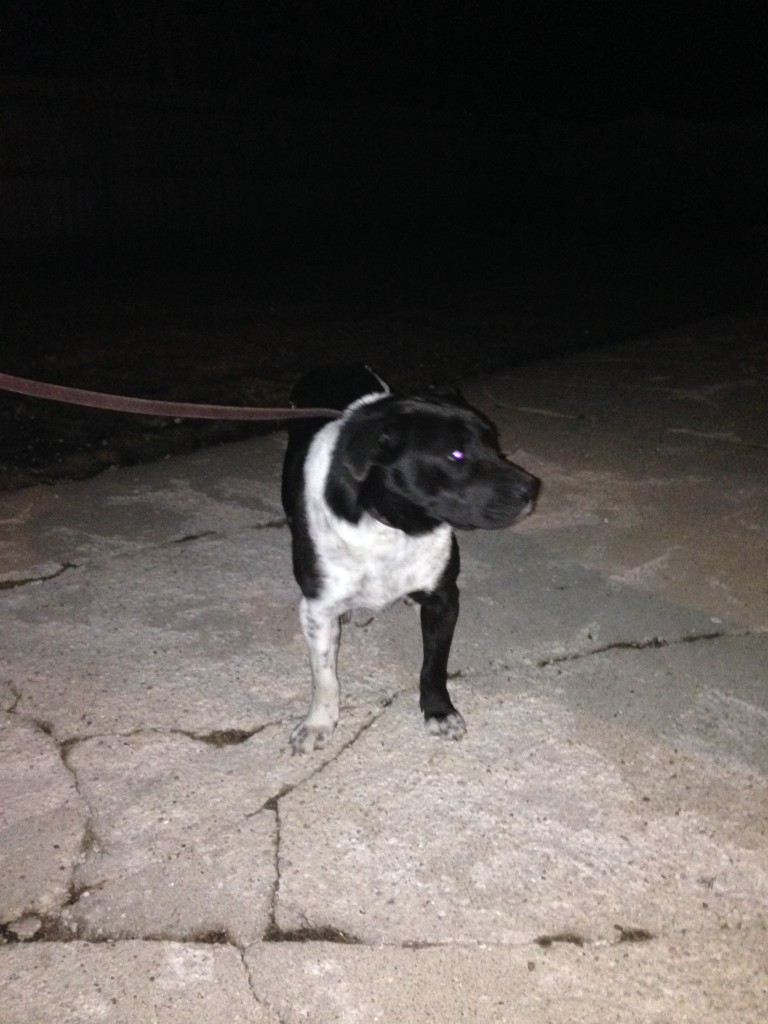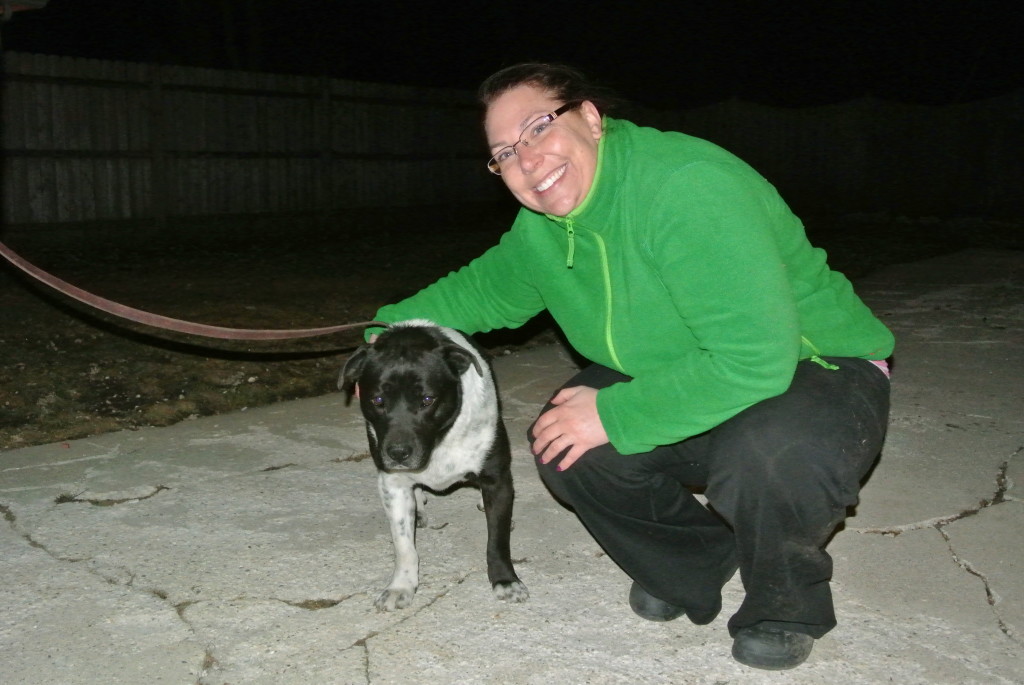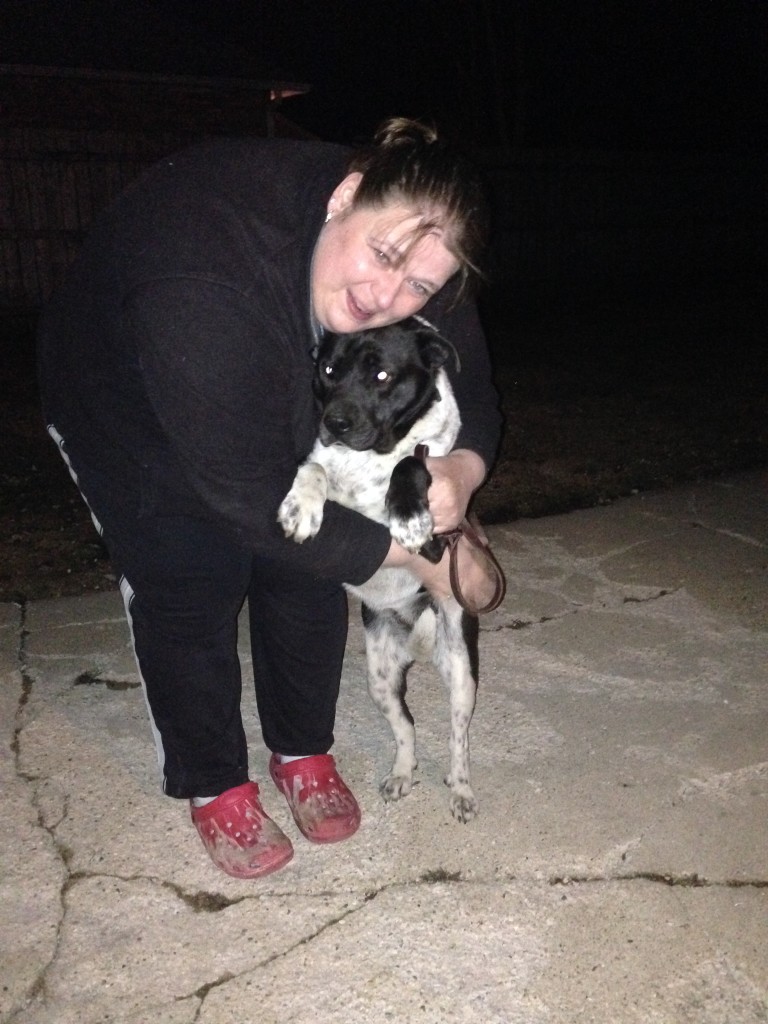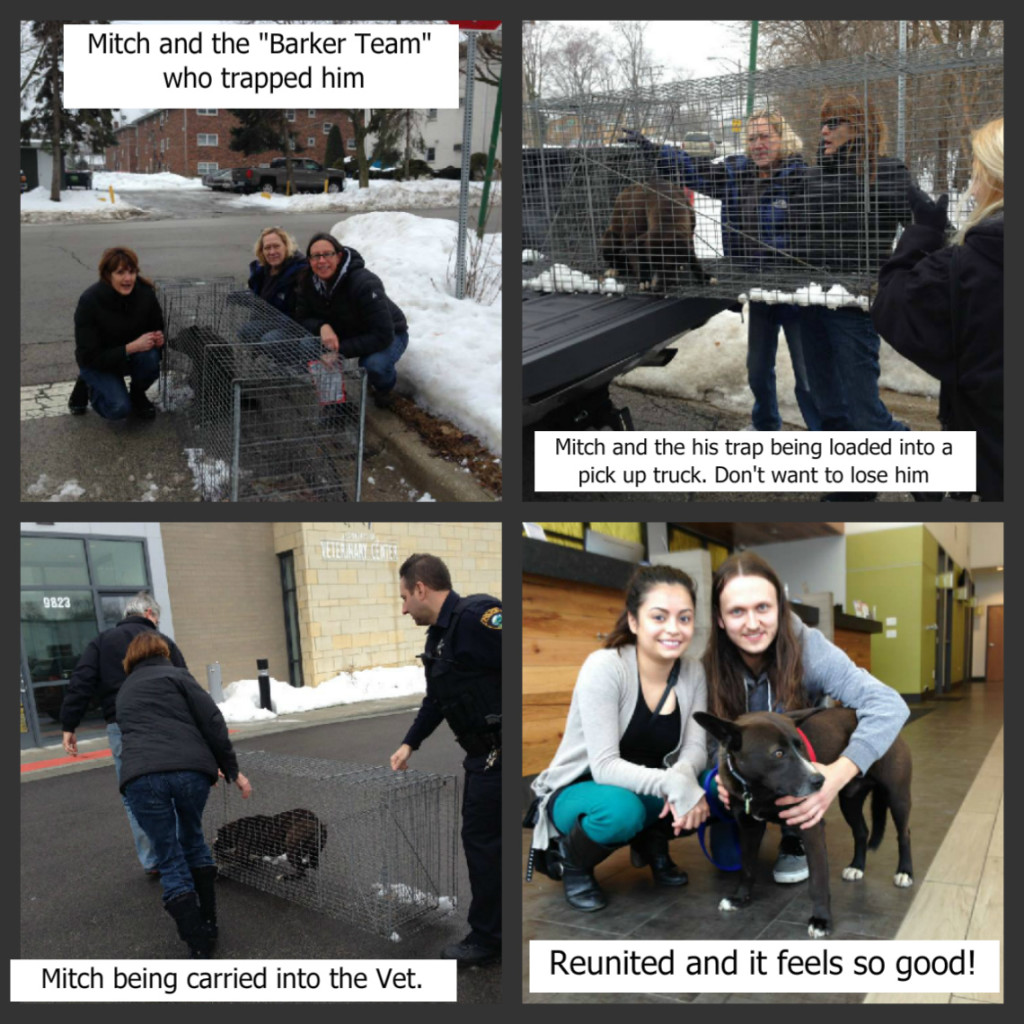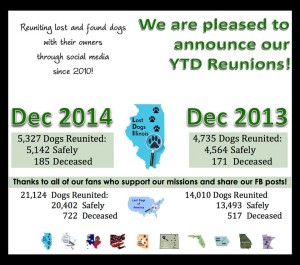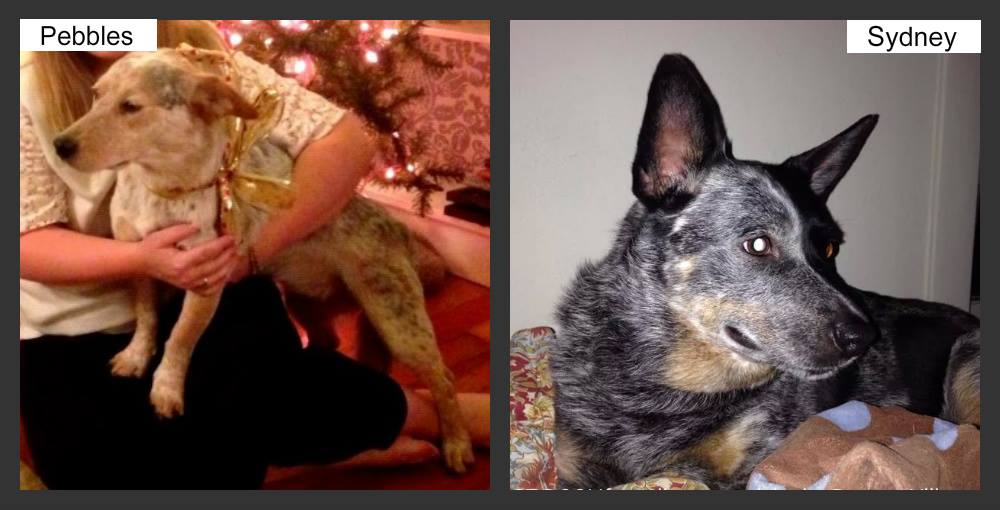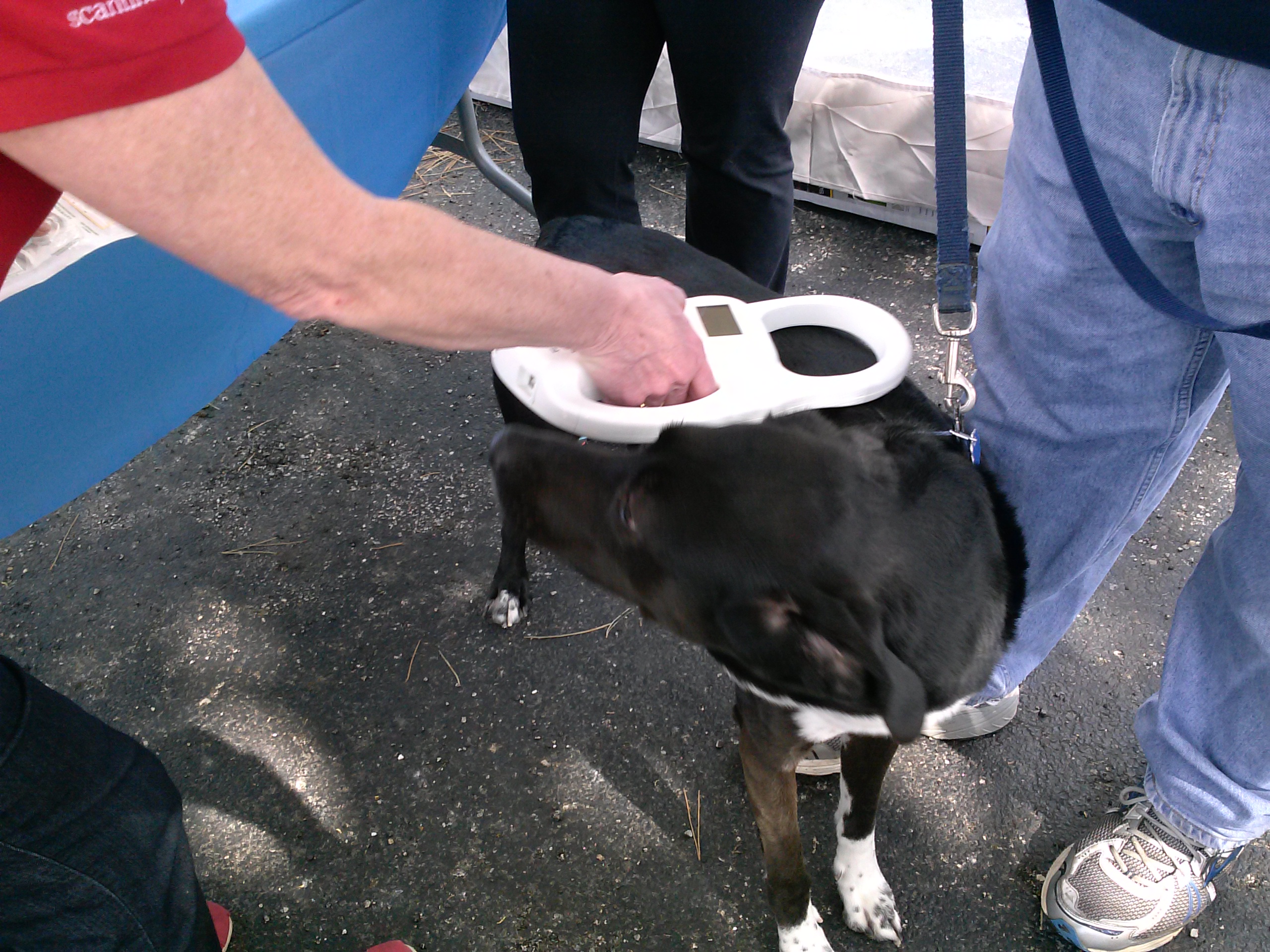On an early January evening, while cooking dinner, one of my dogs started barking like crazy at our front door. I went to see why she was barking, and saw a black & white dog in the driveway across the street. I immediately went out and tried to call her, but she just looked at me, went up the driveway and was gone. I rang my neighbor’s doorbell and told them about her. They informed me that they had been seeing her for a couple of weeks. I called Animal Control because I thought it might be someone’s dog from our neighborhood. When the Animal Control officer arrived they did a “drive-by”, didn’t see her, and left. I checked Lost Dogs Illinois’ website to see if I could find any similar dogs that had been posted as missing in the previous two weeks with no luck.
A couple of days went by without a sighting. That Saturday we decided to walk around the neighborhood to see if we could spot her, and we did! We called Animal Control again. When the officer arrived I gave him a description of the dog. He informed me that they had been looking for the same dog for 6-8 weeks. I went back on the Lost Dogs Illinois website to search for missing dogs back to November or December. That is when I saw Pebbles. She had been missing since November 24th from Carpentersville. I wasn’t sure if that was really the dog I was seeing because we live in Elgin. We are about 10 miles from where she was last spotted. Could this really be Pebbles?
At first we were unsure if we should contact the person who posted her to LDI’s page. We weren’t positive it was Pebbles, because she wouldn’t let us get close enough to get a good look, but the similarities were uncanny. Our thought was “some hope is better than no hope” so we got in contact with Rayann, Pebbles’ foster mom. She informed us that Pebbles had gotten out while on a trial adoption with a family in Carpentersville.
Rayann and another woman came out the next night to help us search for her. We had no luck that night, but told Rayann we would not stop trying and would text her if we spotted Pebbles again. Steve spent countless hours tracking and searching the neighborhood. He was out there in a blizzard, and on many below-zero nights, hoping to find signs of where she was sheltering. He had a few leads, but never truly found her it. Pebbles did lead him on a couple of nice long walks around the neighborhood as she darted in between houses and through yards.
We then set up a feeding station at our house, handed out flyers, and knocked on peoples’ doors to generate sightings. It turned out that a lot of people had seen Pebbles. We installed video cameras at our house so we could watch and record when the dog was coming to eat. The first time we got her on video, I sent it to Rayann, and she confirmed it was in fact Pebbles!
At that point, we weren’t sure how we were going to catch her. That’s when I saw a post on LDI’s Facebook page about a dog that had been missing for a year and was recently caught. I commented on the post saying how it gave us hope about catching Pebbles. Susan Taney and Katie Campbell replied to my comment and from there we started messaging on Facebook.
Susan informed me that she had a trap we could borrow. The next night, Susan drove out to our house and showed us how to set the trap and explained how to lure Pebbles into it. We spent two weeks slowly moving the feeding station into the trap. Then, at 3:59am on February 22nd Pebbles worked up the nerve to go all the way into the trap. She set off the trap but, unfortunately, the trap door bounced and she was able to get out. Our hearts were broken. The next day we started the process of slowly moving the feeding station into the trap again. Pebbles was now so leery of the trap that she wouldn’t go anywhere near it. It was time to devise a new plan.
After consulting with Susan and Katie, we decided it would be best to try and get her into our backyard. My husband, Steve, is very handy and extremely talented when it comes to thinking outside the box and putting those ideas into motion. He thought that if we could get her into our backyard and figure out a way to get the gate to close behind her, we could catch her. He rigged up a whole pulley system with ropes and bungee cords tied to our gate, with the other end of the rope tied to a frozen hot dog. Pebbles had a history of taking the food we left out for her and running off with it to eat somewhere else. If she tried to take the hot dog and run she would set off the trap, and the gate door would close behind her before she could get out. Once again, Pebbles outsmarted us. She came into our back yard several times, but each time decided to lie down and enjoy her hot dogs in peace. Again, it was time to figure out a new plan.
Steve made some adjustments to his design, and decided that he was going to attach a rope to the gate and bring it up to the front porch of our house. We were hopeful that when we saw her on the camera in the backyard, we could go out front and pull the rope to close the gate. We tried this every night for about a week, but Pebbles would never come when we were awake. She somehow knew exactly when we went to bed and would show up about 10 minutes later. We nicknamed her “Santa” because she “knew when we were sleeping and when we were awake”. She would then wander around our yard and peacefully eat her hot dogs.
Finally, on March 17th , Steve decided he was going to stay up late to see if she would come. It was around midnight when he saw her on the camera. Her head popped through the open gate and she looked around. She then came all the way into the yard and started sniffing around. Steve immediately went out our front door and pulled the rope with all his might to shut the gate. The gate was closed and she was now in our back yard! I was awakened when he said “I got her…she’s in the back yard!” I instantly called Rayann to tell her the news. She was so excited that she got dressed and headed out our way. Now we had to try to get the slip lead on her, and it wasn’t going to be easy. Pebbles is extremely fearful of people…even those whom she had been seeing and smelling, and who were feeding her daily.
I messaged Katie and Susan for advice. Katie suggested one of us go out there with food, sit down, and slowly scooch our way toward Pebbles. I armed myself with a bowl of cut up hot dogs and headed to the backyard. I sat down and had Pebbles in my sight, never making direct eye contact with her. I used yawning and lip licking as calming signals, while pretending to eat the hot dog pieces and gently tossing some to her. Every couple of minutes I would scooch a little closer and she would move away a little more. After about an hour and a half I was able to get her in the corner behind our garage and shed. She let me get close enough that I could softly pet her and tell her it was going to be ok. I pulled the slip lead out of my pocket and gently slid it over her head. She never resisted. She knew her ordeal was over and she was safe. I called Steve to let him know that he and Rayann could come outside. Rayann was so happy to see Pebbles, and Pebbles was happy to see her too! We were all in tears.
On March 18th at 2:00am, after three months, several failed attempts, a blizzard, below zero temperatures, accidentally trapping a raccoon, and overwhelming concern for her safety, Pebbles was finally safe! Pebbles is now in her forever home with Rayann (who is going to adopt her!) and all of her doggie siblings. She got a bath, a new collar and tags, and is proudly strutting around showing everyone. A very happy ending to a long adventure for everyone!
Thank you Amy for sharing your story! You and Steve rock as Good Samaritans!

